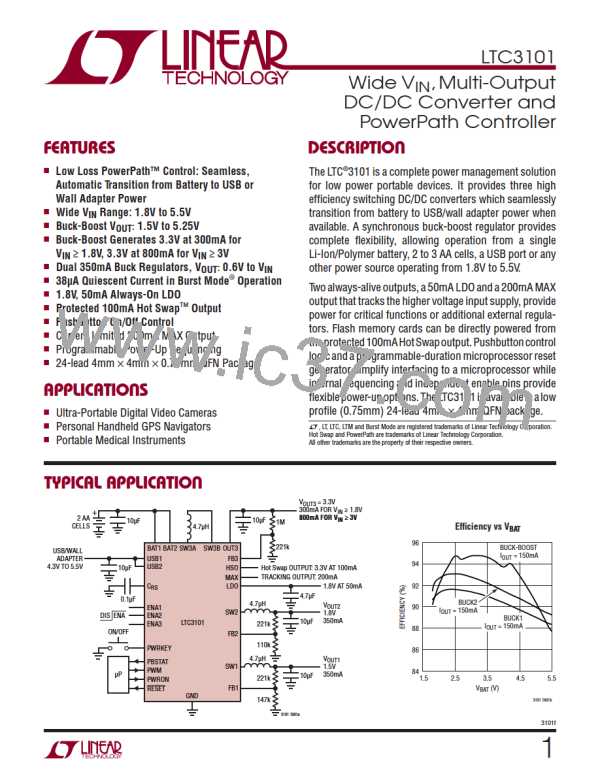LTC3101
PIN FUNCTIONS
PWM (Pin 1): Pulse Width Modulation/Burst Mode Se-
lection Input. Forcing this pin high causes all switching
converters to operate in low noise fixed frequency PWM
mode. Forcing this pin low enables Burst Mode operation
for all converters. With PWM held low, the buck-boost
converter will operate solely in Burst Mode operation and
can only support a minimal load current (typically 50mA).
With PWM low, the buck converters will automatically
transitionfromBurstModeoperationatlightloadcurrents
to PWM mode at heavy load currents.
PWRKEY (Pin 8): Pushbutton Power ON/OFF Key. Forcing
this pin to ground will turn on the LTC3101 DC/DC con-
verters in the internally controlled sequence and initiate a
microprocessor reset. This pin is usually connected to an
external momentary switch that is used to turn on the IC.
This pin has an internal pull-up resistor that is automati-
cally connected to the higher of the two input supplies,
battery or USB.
PBSTAT (Pin 9): Power ON/OFF Key Status Pin. This is a
debounced, open-drain output that indicates the state of
the PWRKEY pin to the microprocessor. In the typical ap-
plication, the microprocessor monitors this pin to detect
a second pushbutton activation indicating a power-down
request.
SW1(Pin2):BuckConverter1SwitchPin. Thispinshould
be connected to one side of the buck inductor.
BAT1(Pin3):BatteryPowerInputforBothBuckConverters.
A 4.7ꢀF or larger bypass capacitor should be connected
betweenthispinandground. Thebypasscapacitorshould
be located as close to the IC as possible and should via
directly down to the ground plane. Pins BAT1 and BAT2
must be connected together in the application.
LDO (Pin 10): Always-Alive LDO Output. This output is
internally regulated to 1.8V (typical) and is guaranteed to
supply an external load of up to 50mA. The LDO output
is always active whenever either supply, battery or USB
power, is present (independent of the states of all enables
and the pushbutton interface). This output can be utilized
to power an external real time clock or charge a superca-
pacitor for temporary memory backup when both power
sources are removed.
USB1 (Pin 4): USB or Wall Adapter Power Input for Both
BuckConverters.A4.7ꢀForlargerbypasscapacitorshould
beconnectedfromthispintoground.Thebypasscapacitor
shouldbelocatedasclosetotheICaspossibleandshould
viadirectlydowntothegroundplane.PinsUSB1andUSB2
must be connected together in the application.
MAX(Pin11):PowerOutputThatTrackstheHigherVoltage
Input Supply. This output is driven to the higher of the two
power inputs, USB2 or BAT2. This output can support a
loadcurrentofupto200mAandisshort-circuitprotected.
The MAX output can be used to power an LCD display or
external LDOs. The MAX output is operational whenever
either supply, BAT2 or USB2, is present, independent of
the state of all enables and the pushbutton interface.
SW2(Pin5):BuckConverter2SwitchPin. Thispinshould
be connected to one side of the buck inductor.
PWRON (Pin 6): Power-On Input. Forcing this input high
enables the IC. Typically, the PWRKEY input is used to
initially enable the LTC3101 while the microprocessor is
powering up. Once the microprocessor is initialized, it
forcesPWRONhightokeeptheLTC3101enabledwhenthe
momentarypushbuttonconnectedtoPWRKEYisreleased.
In applications that do not require pushbutton control, the
IC can be enabled directly by forcing PWRON high.
C
(Pin 12): Power-on Reset Duration Programming
RS
Capacitor. An external capacitor is connected from C to
RS
ground to set the duration of the microprocessor power-
on reset signal.
FB3 (Pin 7): Feedback Voltage Input for the Buck-Boost
Converter. The resistor divider connected to this pin sets
the output voltage for buck-boost converter.
3101f
10

 Linear [ Linear ]
Linear [ Linear ]